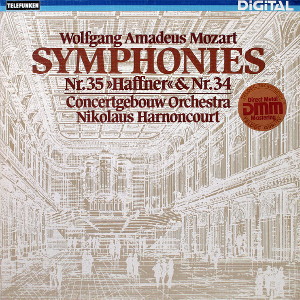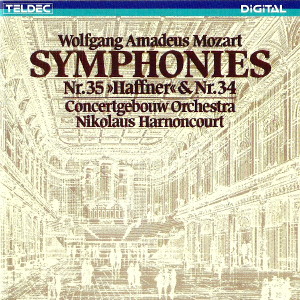 |
1 LP -
6.42703 AZ - (p) 1981
|
 |
| 1 CD -
8.42703 ZK - (c) 1983 |
|
| Wolfgang Amadeus
Mozart (1756-1791) |
|
|
|
|
|
|
|
| Symphonie Nr. 35 D-dur,
KV 385 "Haffner" |
|
22' 20" |
|
| - Allegro con spirito |
5' 50" |
|
A1 |
- Andante
|
9' 10" |
|
A2 |
| - Menuetto |
3' 20" |
|
A3 |
- Presto
|
4' 00" |
|
A4 |
| Symphonie
Nr. 34 C-dur, KV 338 |
|
22' 19" |
|
| - Allegro vivace |
7' 42" |
|
B1 |
- Andante di molto (più
tosto Allegretto)
|
6' 45" |
|
B2 |
- Allegro vivace
|
7' 52" |
|
B3 |
|
|
|
|
| CONCERTGEBOUW-ORCHESTER,
AMSTERDAM |
|
| Nikolaus
Harnoncourt, Dirigent |
|
|
Luogo
e data di registrazione
|
| Concertgebouw,
Amsterdam (Olanda) - novembre 1980 |
|
Registrazione
live / studio
|
| studio |
Producer
/ Engineer
|
-
|
Prima Edizione CD
|
| Teldec
- 8.42703 ZK - (1 cd) - 44' 39" - (c)
1983 - DDD |
Prima
Edizione LP
|
Telefunken - 6.42703
AZ - (1 lp) - 44'
39"
- (p) 1981 - Digital
|
|
|
Notes
|
The two works on this
recording are Mozart’s last symphony
written in Salzburg and his first
written in Vienna. Both occupy a
special position in his symphonic
output, indeed in the general
development of the symphony; K 338 in
C major was an abandoned attempt at
espousing once again the Viennese
tradition, the “Haffner” on the other
hand an attempt to combine this
tradition with the Salzburg Serenade
tradition. A great part of the charm
of both works lies in these
circumstances.
K. 338 is dated 29th August 1780,
which means that more than a year had
elapsed since the composition of its
predecessor, K. 319. That Mozart
deliberately set out to write
something entirely different is shown
by the fact that originally there were
four movements, including a minuet
which most unusually came second
rather than third. This was later
removed by him and appears to have
been destroyed except for the first
14 bars, which were
written and then crossed out on the
reverse of the last page of the
opening movement, possibly in
deference to Salzburg taste, certainly
the four-movement
design prevalent in Vienna was reduced
to the more generally accepted three
of the “Italian” type.
The minuet K. 409, which is often
interpolated into K 338, was written
at a later date, probably in Vienna in
1782, as an independent concert piece;
it is quite unsuitable for inclusion
in K. 338, not only because it is
scored for different instruments, but
also on account of its length and
style,
Not only the subsequent excision of
the minuet, but
also the whole design of the first
movement point to the Italian
tradition, even though this is
interpreted in a highly individual
manner. Its basic tone is established
by the grand and festive opening,
which combines overture and march
styles, even though this tone is
dramatically darkened after a mere 12
bars - first by a brief appearance of
F minor, and then repeatedly by
chromaticism and sighing motifs. The
dramatic element revealed in this way
imparts a remarkable character to the
quasi development section, which
evolves without exploiting any of the
themes of the exposition, entirely by
means of these dramatic gestures: the
whole atmosphere is strangely
disquieting, dominated by broken
chords, sighs and chromatic runs,
altogether in immediate and total
contrast to both exposition and
recapitulation. Hardly anywhere else
did Mozart write a development section
so clearly intended to contrast in its
emotions with those of the outer
sections of the movement; this
application of extremes may also be
the reason why the recapitulationis
followed by an unusually long coda, in
which the principal subject and the
key of C major only win through, as it
were, in the very last moment.
After this extraordinary first
movement, the second and third appear
to be rather more conventional. The
andante, labelled “Andante di molto”
in the autograph and later expanded to
“Andante di molto più
tosto Allegretto” is a very simple
songlike, binary movement in F major;
there are no wind instruments, though
the bassoons play the bass line. The
finale, derived from the jig but
almost a tarantella, reverts to the
conception of the first
movement in that the development once
again provides the emotional contrast
without making use of the themes;
Mozart did, however, take account of
the character appropriate to a finale
by making the contrast less sombre and
dramatic, but rather more episodic.
The Haffner Symphony, K. 385, was the
second work that Mozart wrote
specially for the Salzburg family
Haffner, the first being the Serenade
K 250/248 b. Originally also planned
as a serenade, it was commissioned via
Leopold Mozart for the ennoblement
of Sigmund Haffner junior on 29th July
1782, at a time when Wolfgang was
deeply unsettled by the success of his
opera “Die Entführung
aus dem Serail”, his efforts to build
on this success, and not least by his
marriage. Accordingly, the writing was
fraught with problems and dragged on
until long after the celebrations in
Salzburg. A mere nine days before the
date stipulated he wrote: “Now I have
work in plenty. By Sunday week I have
to arrange my opera for wind band,
otherwise someone will beat me to it
and rake in the profit in my place;
and now I am to write anew symphony as
well! How on earth
can l do it? (...) Oh well, I’ll
have to do it at night, there’s no
other way - and I am happy to make the
sacrifice for you, dearest father.
You may be sure that there will be
something by cvcry mail - and I shall
work as fast as possible - and insofar
as time permits - well.”
(20th July l782.) A Week later,
however, only the first movement was
ready; “You will be surprised only to
see the first allegro; but there is no
way round it - I suddenly had to write
a serenade, but only for wind band
(otherwise I could have used it for
you as well). On Wednesday 31st I will
send the two minuets,
the andante and the last movement; if
I can, I shall also send you a march,
if not, you’ll just have to play the
one in the Hafner music, which is
quite unknown. I have written
it in D because you prefer it that
way.” (27th July l872.) The letter of
3lst July reads: “As you see, the will
is there, but if I can’t, I can’t: I
just won’t do a slipshod job.
Therefore I can only let you have the
whole symphony by the next mail. I
could have sent you the last movement,
but I`d sooner put it all together,
and the postage will
be the same.” At last the march, which
had been planned from the beginning,
was ready: “Here
is a short march for you. I do hope
that everything will arrive in time,
and be to your liking. The first
allegro must be very fiery; and the
last as fast as possible,” (7th
August.) His father appears to have
approved of the work, even though it
arrived too late for the actual
celebrations of`Haffner’s ennoblement:
“How pleased I am that the symphony is
to your liking.” (24th
August 1782.)
When Mozart was planning to give a
series of concerts in Vienna at the
beginning of 1783, he
asked for the return of the “Hafner
musique”. It had so completely slipped
from his memory that he marvelled
at its quality: “I was quite surprised
by the new Hafner symphony, for I had
forgotten every single note; it must
certainly be very effective.” (15th
February 1783.) For the
performance on 23rd March 1783 Mozart
adapted his score both to the
resources and the symphonic traditions
in Vienna by adding flutes and
clarinets to the first and last
movements, and by deleting the march
(presumably K, 385 a/408 No. 2) and
the first minuet, which is now lost.
Certainly the Haffner symphony in its
final “symphonic” form is obviously
still a transitional work, in that the
outer movements have the festive
sound, the minuet the simplicity, and
the galant andante the elegance of a
serenade; but at the same time the
dimensions, the concentrated thematic
work and the contrapuntal texture of
the work are entirely symphonic. The
two latter attributes are the first
results of the creative study of Haydn
on the one hand and of Bach and Handel
on the other,on which Mozart embarked
in the spring of 1782.
The finale, however, is a whirling
moto perpetuo with more than a hint of
the Osmin music from “Seraglio”, a
typically Mozartian combination of
theatrical and orchestral music of the
type which had produced such strange
fruit in K. 338. It is principally due
to this fusion of his individual
conception of instrumental language
with the new demands that Haydn had
made on the symphonic genre that the Haffner
symphony proved to be Mozart’s first
truly classical symphony.
Ludwig
Finscher
Translation:
Lindsay Craig
|
|
Nikolaus
Harnoncourt (1929-2016)
|

|

|
|